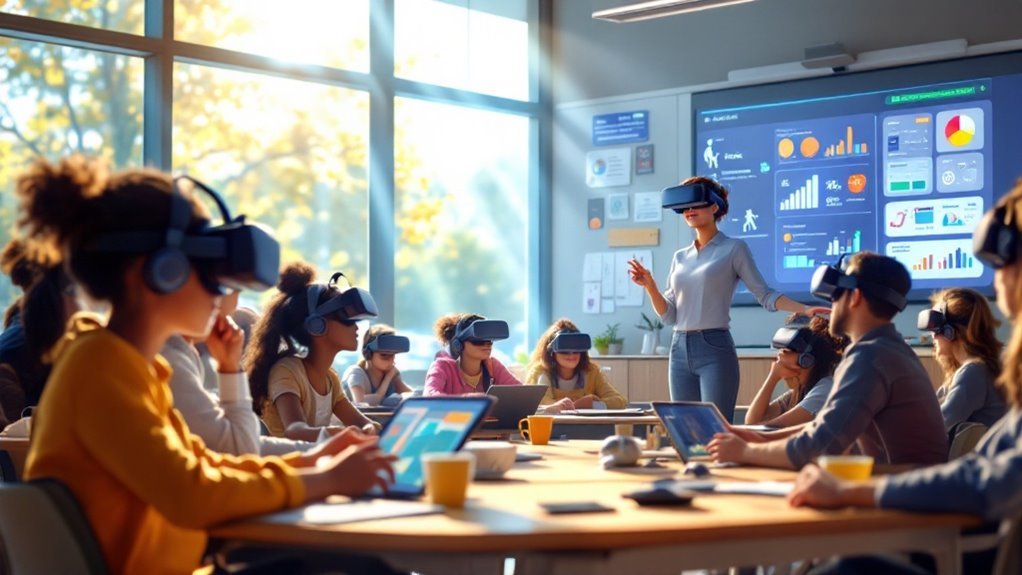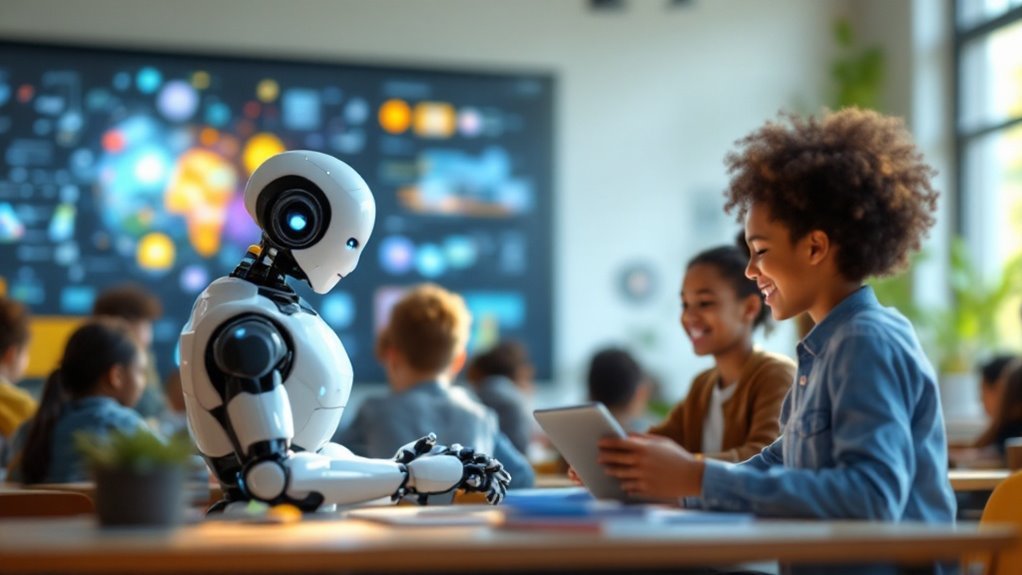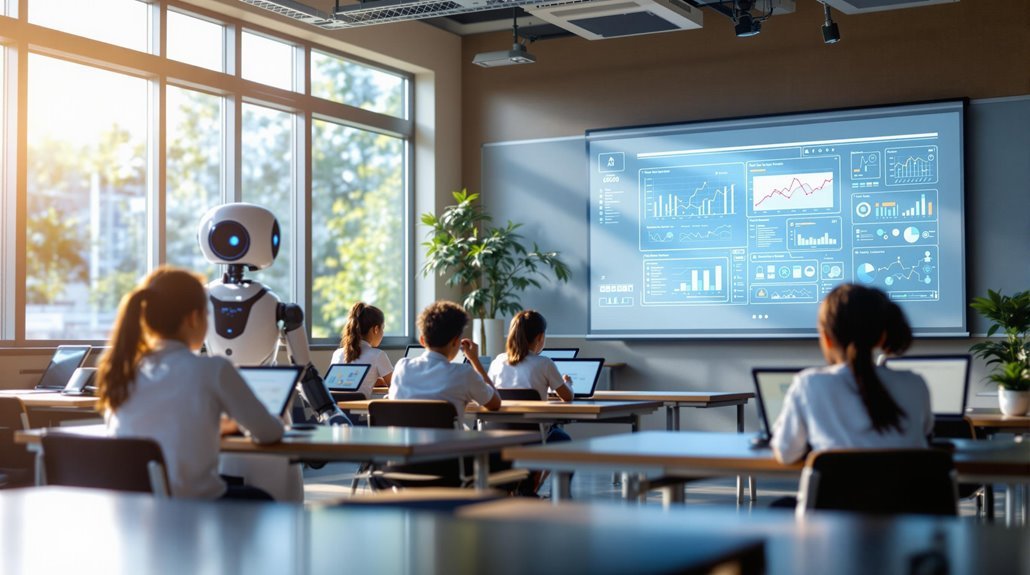AI is poised to dominate education, transforming how you learn and interact with knowledge. Key trends to watch include personalized learning, where AI tailors experiences to your individual needs and preferences, enhancing engagement. Automation simplifies administrative tasks, freeing up time for more meaningful educational interactions. You'll additionally see immersive environments leveraging virtual and enhanced reality, making learning experiences more engaging. With significant market growth projected, AI's integration into classrooms will optimize lesson plans and improve accessibility. If you stay attuned to these shifts, you'll uncover how they reshape the educational environment.
Key Takeaways
- The shift towards personalized learning will be accelerated by AI, enhancing student engagement and tailoring educational experiences to individual needs.
- Interactive learning experiences, powered by AI and immersive technologies, will increase information retention and prepare students for real-world applications.
- Data-driven insights will enable adaptive learning environments, allowing real-time adjustments to lesson plans based on student performance metrics.
- Automation of routine tasks through AI will streamline administrative processes, freeing educators to focus on personalized instruction and student interaction.
- The AI in education market is projected to grow significantly, driven by increased demand for personalized learning and government investments in educational technologies.
Personalized Learning Revolution

Personalized Learning Revolution
In the rapidly evolving environment of education, personalized learning is revolutionizing how students engage with content and master skills. By leveraging AI algorithms, you can experience tailored educational experiences that adjust to your unique performance, preferences, and learning patterns. This student-centered pedagogy nurtures deeper understanding as you navigate adaptive learning paths that respond to your progress and interests. With real-time feedback, educators can offer timely interventions, ensuring you receive support precisely when you need it. AI-driven learning analytics provide insights into your strengths and weaknesses, further enhancing the effectiveness of personalized learning.
The benefits extend beyond mere engagement; personalized learning improves retention and comprehension, leading to enhanced learning outcomes. You can focus on challenging topics, mastering skills at your own pace, while AI-driven analytics empower educators to make data-driven decisions that optimize your learning experience. This individualized assessment approach not only caters to your learning style but also increases accessibility to high-quality educational content.
As the setting continues to shift, the integration of advanced technologies, like virtual reality and natural language processing, will further improve these personalized experiences. Embracing this revolution means you'll be better equipped to thrive in an ever-changing world, where education becomes a truly customized journey.
Automation in Educational Tasks
Education's environment is rapidly transforming as automation takes center stage, reshaping how educators and students interact with the learning process. By automating routine tasks like assignment assessment and test grading, you can markedly improve grading efficiency and streamline administrative processes. This shift allows educators to dedicate more time to personalizing learning experiences and engaging deeply with their students.
Automated feedback plays an essential role in this evolution, providing swift and consistent evaluations that directly inform students' progress. When AI analyzes student work, it identifies performance patterns, enabling targeted support for those who need it most. This guarantees prompt feedback, improving the learning cycle and promoting equitable assessment across diverse learning styles. Additionally, AI tools facilitate the identification of skill gaps through performance data analysis, ensuring that students receive the tailored support they require.
Moreover, automation optimizes class timetables and resource allocation, freeing up educators to focus on nurturing critical thinking and creativity. Tasks such as generating reports, organizing research papers, and even scheduling reminders can all be efficiently handled by AI, promoting a more organized and productive educational environment. As you adopt these innovations, you're not only improving the quality of teaching but additionally cultivating a collaborative atmosphere where students can thrive.
Enhancing Accessibility With AI

The integration of AI in education considerably improves accessibility, ensuring that all students can engage meaningfully with learning materials. By harnessing accessible technology, AI promotes inclusive education through adaptive tools that cater to diverse learning needs. For instance, text-to-speech (TTS) and speech-to-text (STT) technologies serve as essential communication aids, enabling students with disabilities to interact with digital resources effectively.
| AI Tools | Benefits |
|---|---|
| Text-to-Speech (TTS) | Supports visually impaired students |
| Speech-to-Text (STT) | Assists those with physical disabilities |
| Real-time Captioning | Aids hearing-impaired students |
| Adaptive Learning Platforms | Customizes content for individual needs |
Moreover, AI promotes learning equity through assistive devices and personalized learning pathways. By continuously evaluating student performance, AI adapts content in real-time, ensuring all learners can thrive. In addition, alternative content formats, such as simplified reading materials and language translation, empower students from varied backgrounds and abilities. Ultimately, AI's role in enhancing accessibility signifies a transformative step towards a more equitable educational environment.
Virtual Learning Environments
In today's digital environment, virtual learning settings are reshaping how you access education. With improved accessibility options and interactive experiences, you can engage with personalized strategies that cater to your unique learning style. This transformation not only boosts motivation but also nurtures a deeper connection to the material, making learning more effective and enjoyable.
Enhanced Accessibility Options
Releasing the potential of improved accessibility options in virtual learning environments is transforming how students engage with educational content. By harnessing accessible technology, educators are paving the way for inclusive education that caters to diverse learning needs. Here are four key improvements reshaping the environment:
- Personalized Learning Paths: AI analyzes your unique performance and preferences, crafting tailored paths that align with your strengths while addressing areas needing improvement.
- Support for Students with Disabilities: Innovative tools like speech-to-text and text-to-speech applications adapt materials to meet auditory and visual needs, ensuring everyone has access to quality education.
- AI-Driven Content Creation and Curation: Generative AI creates customized study materials and quizzes, boosting your ability to engage deeply with content that resonates with you.
- Seamless Communication and Collaboration: AI-powered tools promote effective communication among diverse groups, breaking down language barriers and nurturing collaborative learning experiences.
These advancements not only bridge knowledge gaps but also create an environment where every student can thrive, marking a significant shift toward a more equitable educational environment.
#
Interactive Learning Experiences
Interactive learning experiences in virtual environments are revolutionizing education by engaging students in dynamic and immersive ways. The integration of interactive simulations and collaborative platforms creates a learning environment where students actively participate rather than passively absorb information. With tools like virtual classrooms and discussion forums, you can collaborate with peers from around the globe, enhancing the educational experience through shared insights and diverse perspectives.
Technological advancements such as VR and AR provide realistic simulations that greatly boost information retention—up to 75% more than traditional methods. As you navigate these immersive environments, you're not just learning; you're practicing skills in safe, controlled settings. Furthermore, the use of AI-driven systems allows for real-time feedback, making learning more responsive and tailored to your needs.
The efficiency of online learning can't be overstated. Studies show it can reduce study time by up to 60% while improving retention rates dramatically. The combination of these elements within virtual learning environments not only encourages engagement but also prepares you for the complexities of real-world applications, ensuring you're equipped for the future. Adopt these innovations; they're paving the way for a transformative educational experience.
Personalized Engagement Strategies
The shift towards interactive learning experiences sets the stage for implementing personalized engagement strategies in virtual learning environments. By leveraging AI, you can create a more customized and motivating educational experience for every student. Here are four key strategies to improve personalized engagement:
- Customized Content: Use AI algorithms to analyze student data and develop tailored learning paths that resonate with individual interests and learning styles.
- Multimodal Learning: Incorporate various formats—text, audio, video—to cater to different learning preferences, making the experience more engaging and thorough.
- AI-Powered Recommendations: Implement AI to suggest relevant resources based on students' profiles and past performance, promoting deeper engagement and ongoing motivation.
- Automated Support and Feedback: Utilize AI agents in Learning Management Systems to provide instant feedback and 24/7 support, ensuring students stay connected and informed.
## Interactive Learning Experiences

As you investigate the domain of interactive learning experiences, you'll notice how improved engagement strategies transform the educational environment. Real-time collaboration tools not only promote teamwork but additionally adapt learning settings to meet diverse needs. By leveraging these advancements, you can create a more dynamic, personalized, and effective learning journey.
Enhanced Engagement Strategies
Engaging students in the learning process has become increasingly important, and leveraging AI technologies is revolutionizing how this is achieved. By implementing improved engagement strategies, you can nurture a more dynamic educational environment. Here are four key aspects to reflect on:
- Adaptive Learning Paths: AI tailors learning experiences to match individual preferences and styles, ensuring that every student feels included and understood.
- Real-Time Feedback: With immediate adaptive feedback, students can correct errors on the spot, improving their understanding and keeping them focused.
- Emotional Intelligence: AI's ability to detect emotions allows for personalized support, helping you adjust teaching methods when students show signs of confusion or disengagement.
- Immersive Experiences: Utilizing VR/AR can transform lessons into lifelike simulations, making learning both engaging and memorable.
Real-Time Collaboration Tools
Harnessing the power of real-time collaboration tools can greatly improve interactive learning experiences in educational settings. These innovative collaborative tools, such as Microsoft Teams and Blackboard Collaborate, augment communication platforms where students and educators engage seamlessly. By facilitating synchronous collaboration, these technologies empower users to brainstorm ideas visually through interactive whiteboards like MURAL and Figma, nurturing creativity in project management.
Moreover, document sharing becomes effortless with Google Workspace and Microsoft 365, enabling real-time updates and feedback mechanisms that keep everyone on the same page. Tools like Nearpod and Lumio by Smart transform lessons into dynamic experiences, integrating quizzes and group activities that encourage participation.
In remote learning environments, platforms like Padlet and Flip offer unique opportunities for interactive engagement, allowing students to present work and receive instant feedback. As educational technology continues to evolve, embracing these tools will revolutionize how knowledge is shared and constructed, driving the future of learning. By leveraging these advancements, educators can create enriched learning environments that cultivate collaboration, creativity, and critical thinking among students.
Adaptive Learning Environments
Adaptive learning environments are transforming education by offering personalized learning experiences tailored to individual student needs. By leveraging AI algorithms and learning analytics, these platforms adapt in real-time, ensuring you receive the most effective education possible. Here are four key innovations that stand out:
- Continuous Monitoring: With adaptive feedback, systems analyze your performance and adjust lesson plans instantly, making learning more efficient.
- Customized Content: Generative AI crafts unique materials designed specifically for you, catering to your strengths and weaknesses.
- Engagement Boost: Interactive content, gamification, and immersive technologies like VR create a stimulating learning atmosphere, greatly improving your motivation and confidence.
- Inclusivity: Adaptive learning is breaking down barriers for students with disabilities or language challenges, ensuring everyone has access to quality resources.
As you navigate these adaptive environments, keep in mind how they promote a culture of continuous improvement and personalized support. The integration of predictive analytics and real-time adjustments not only improves academic performance but likewise contributes to overall well-being, shaping an innovative future in education. Welcome these changes as they redefine what learning can be.
Data-Driven Educational Insights
Data-driven educational insights are transforming the way educators approach teaching and learning. By harnessing data analytics, you can gain a clearer understanding of student performance metrics, allowing for tailored interventions and improved educational outcomes. Standardized tests and classroom assessments provide crucial data, enabling you to identify areas where students struggle and where they excel.
The integration of predictive algorithms takes this a step further, forecasting student needs before they become critical. You can leverage insights from attendance records, digital learning platforms, and student feedback to create a comprehensive view of each learner's journey. This combination of quantitative and qualitative data not only improves personalized learning experiences but additionally promotes evidence-based decision-making.
Moreover, by implementing learning management systems (LMS) and training educators to interpret data effectively, you encourage a culture of continuous improvement. You can support targeted interventions that proactively help students at risk of falling behind. As you adopt these data-driven strategies, you're not just optimizing educational practices; you're ensuring that every student receives the individualized support they need to thrive in an increasingly complex learning environment.
Market Growth Projections

The global AI in education market, valued at USD 4.17 billion in 2023, is poised for explosive growth, projected to reach USD 53.02 billion by 2030. This remarkable increase signals a significant shift in how educational institutions will leverage technology. You'll want to keep an eye on these key trends:
- Market Segmentation Analysis: Personalized learning is expected to grow from USD 5.2 billion in 2022 to USD 48.7 billion by 2030, showcasing the demand for tailored educational experiences.
- Regional Growth: North America leads with a 40% CAGR, while Asia Pacific is set to expand rapidly owing to widespread gadget usage.
- Investment Trends: Significant government spending on education initiatives fuels market growth, particularly in digital learning solutions.
- Solutions Segment Dominance: AI-powered Learning Management Systems (LMS) and Intelligent Tutoring Systems (ITS) are projected to command a 70.3% revenue share by 2024.
As we move forward, understanding these dynamics will be crucial for stakeholders seeking to innovate and invest wisely in this burgeoning sector. The future of education is undeniably tied to AI's transformative potential.
AI Integration in Classrooms
In today's educational environment, integrating AI in classrooms is revolutionizing how students learn and teachers instruct. By leveraging AI classroom dynamics, educators can implement personalized instructional strategies that cater to individual learning styles and paces. Adaptive software like DreamBox and Smart Sparrow utilizes real-time data to adjust lesson difficulty and sequencing, ensuring each student receives tailored support that addresses their unique educational needs.
Furthermore, AI helps reduce the administrative burden on teachers through automated grading and scheduling. Tools such as Gradescope provide consistent evaluation, allowing you to focus on engaging with students rather than getting bogged down by paperwork. Intelligent Tutoring Systems (ITS) further improve this experience by simulating one-on-one tutoring, identifying knowledge gaps, and delivering targeted mini-lessons that promote effective learning.
AI likewise transforms classroom management by gamifying behavior tracking, motivating students through interactive rewards and engaging content. As these innovations continue to evolve, the potential for AI to enrich the educational experience becomes increasingly apparent, empowering you to cultivate a more dynamic and effective learning environment. Embracing these changes positions you at the forefront of educational innovation.
Improving Student Engagement

To truly improve student engagement, you need to contemplate personalized learning pathways that cater to individual strengths and weaknesses. By integrating interactive learning experiences, you can create an environment where students are not just passive recipients of information but active participants in their education. Real-time engagement analytics will likewise empower you to adjust instructional strategies on the fly, ensuring that every learner remains motivated and challenged.
Personalized Learning Pathways
Personalized learning pathways have emerged as a transformative approach in education, fundamentally enhancing student engagement and success. By leveraging AI, you can experience an individualized curriculum tailored to your unique learning style, preferences, and pace. This method promotes learner autonomy and allows you to take charge of your education.
Here are four key features of personalized learning pathways:
- Adaptive Learning Paths: AI algorithms dynamically adjust content and difficulty based on your performance, ensuring an ideal learning experience.
- Personalized Content and Pacing: The learning material is curated to match your interests and abilities, allowing you to progress at your own speed.
- Automated Feedback and Assessment: Receive real-time feedback tailored to your responses, helping you understand concepts better and learn from mistakes instantly.
- Data-Driven Insights: AI collects and analyzes your data, enabling educators to identify specific areas where you may need additional support.
With these innovations, personalized learning pathways not only improve your engagement but also empower you to take control of your educational journey, ensuring success in a rapidly evolving environment.
Interactive Learning Experiences
Interactive learning experiences are transforming the educational environment, engaging students in ways traditional methods often can't match. By leveraging AI-driven immersive simulations, you can walk on the moon or experience significant historical moments firsthand. These lifelike environments not only capture your interest but also improve retention and understanding of complex subjects.
Furthermore, virtual mentors are redefining the role of educators. These AI-based instructors can guide you through intricate topics, like biology lab dissections, offering real-time feedback tailored to your individual learning style. This dynamic approach guarantees you receive the support you need when you need it.
AI's capacity for generating interactive content—videos, quizzes, and simulations—further enriches your learning experience. The technology adapts challenges and complexity based on your engagement, maintaining motivation and focus. With personalized support from chatbots, you can engage in continuous interactive learning, reinforcing knowledge as you progress.
In this forward-thinking environment, the combination of immersive simulations and virtual mentors promises to uplift education, making it more accessible and engaging for all learners. Embracing these innovations will be vital as we navigate the future of education.
Real-Time Engagement Analytics
As education evolves with innovative technologies like immersive simulations and virtual mentors, real-time engagement analytics emerges as a game-changer for improving student engagement. By tracking engagement metrics such as time spent on lectures and participation in discussions, you can gain valuable insights into student behavior. This data helps identify at-risk students and allows educators to implement timely interventions.
Here are four key benefits of real-time engagement analytics:
- Tailored Learning Experiences: Educators can adjust their teaching methods based on real-time feedback, improving learning outcomes considerably.
- Proactive Support: With immediate insights, you can send personalized resources to struggling students, enhancing retention rates.
- Predictive Modeling: Institutions like the University of Southern California utilize predictive analytics to foresee challenges and intervene early, boosting student satisfaction.
- Adaptive Learning: AI-driven systems can dynamically adjust learning paths, guaranteeing that content remains engaging and relevant to students' needs.
Incorporating these analytics not only cultivates a more personalized educational experience but also guarantees that every student has the support they need to succeed.
Future of AI in Education
The future of AI in education promises a transformative shift in how learning environments operate, making them more efficient and tailored to individual needs. As AI integrates into curriculum development, it'll empower personalized learning experiences, adapting to each student's performance and learning style. This digital transformation will streamline administrative tasks, allowing teachers to focus on meaningful engagement, enhancing their roles rather than replacing them.
However, as we adopt this innovation, we must address AI ethics, student privacy, and equity concerns to guarantee all students benefit. Teacher training will be vital to equip educators with the skills to effectively leverage AI tools while maintaining a human-centric approach.
Furthermore, the integration of AI into learning ecosystems will revolutionize assessments, providing real-time analytics and immediate feedback. This data-driven strategy not only prepares students for a future workforce increasingly reliant on technology but also promotes digital literacy and critical thinking. Ultimately, the policy implications of AI in education will shape its trajectory, necessitating thoughtful regulation to balance innovation with the ethical responsibilities we hold in nurturing the next generation of learners.
Conclusion
As AI continues to reshape education, you can't help but wonder: what's next? With personalized learning, automation, and improved accessibility on the horizon, the classroom of tomorrow is closer than ever. Imagine a world where every student's needs are met with precision, and engagement skyrockets. But with great innovation comes uncertainty. Will these advancements truly benefit all learners, or will they widen existing gaps? The future of education hangs in the balance, and it's up to us to shape it.



